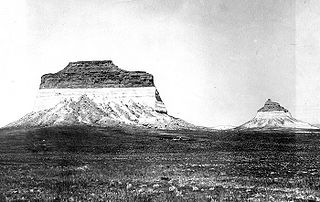| Rosebud Beds | |
|---|---|
| Type | Formation |
| Location | |
| Region | South Dakota |
| Country | United States |
The Rosebud Beds is a geologic formation in South Dakota. It preserves fossils.

Polycotylidae is a family of plesiosaurs from the Cretaceous, a sister group to Leptocleididae. Polycotylids first appeared during the Albian stage of the Early Cretaceous, before becoming abundant and widespread during the early Late Cretaceous. Several species survived into the final stage of the Cretaceous, the Maastrichtian.

The Pierre Shale is a geologic formation or series in the Upper Cretaceous which occurs east of the Rocky Mountains in the Great Plains, from Pembina Valley in Canada to New Mexico.

Pahasapasaurus is a genus of plesiosaur. It was an early polycotylid plesiosaur from the Cenomanian of South Dakota, USA. Distinctive features of the taxon include elongate epipodial bones and the nature of the palate bones. The type species is P. haasi.

Proscalops is an extinct genus of insect-eating mammal. Formerly placed in the defunct order Insectivora, it is now placed with the Eulipotyphla. The first and most numerous Proscalops fossils were found in the Sharps Formation of South Dakota, near Wounded Knee. Other samples have been found in the Brule Formation of South Dakota, the Deep River Formation of Montana, and in Wyoming.
Cylindracanthus is an extinct genus of Cretaceous to Eocene aged ray-finned fish. It is almost exclusively known from bony rostrum fragments as well as some associated teeth, with the rest of the skeleton being cartilaginous. While originally considered to be closely related to billfish, the structure of its rostrum is dissimilar, and is unlikely to be closely related, some later studies suggested closer affinities to the Acipenseriformes. However, this was later rejected due to the lack of osteocytes in histologically examined specimens, which resembles the condition of derived teleosts. A close relation to Blochius has been suggested.
Joffrichthys is a genus of prehistoric bony fish. This North American genus includes three species, J. symmetropterus, J. tanyourus and J. triangulpterus. The last species is known from the Paleocene of the Sentinel Butte Formation of North Dakota.

The Arikaree Formation, also Arikaree Group or Arikaree Sandstone is a geological unit in the central High Plains of the western United States. It preserves fossils dating to the late Oligocene to early Miocene.
The Inyan Kara Group is a geologic group classification applied in South Dakota and adopted in portions of Wyoming and Montana. It preserves fossils of the mid-Cretaceous period. Of late Albian age, this classification correlates with the lower Dakota Formation known in the southwest corner of the State.
The Montana Group is a geologic group in South Dakota. It preserves fossils dating back to the Cretaceous period.

The Harrison Formation is a geologic group in South Dakota and Nebraska. It preserves fossils from the Miocene.

The Minnelusa Formation is a geologic formation in South Dakota. It preserves fossils dating back to the Carboniferous period.
The Batesland Formation is a geologic formation in South Dakota. It preserves fossils dating back to the Neogene period.
The Rosebud Formation is a geologic formation in South Dakota. It preserves fossils dating back to the Neogene period.
The Whitewood Limestone is a geologic formation in South Dakota. It preserves fossils dating back to the Ordovician period.
The Turtle Butte Formation is a geologic formation at Turtle Butte in South Dakota. It preserves fossils dating back to the Paleogene period.
The Monroe Creek Formation is a geologic formation in South Dakota. It preserves fossils dating back to the Paleogene period.
The Sharps Formation is a geologic formation in South Dakota. It preserves fossils dating back to the Paleogene.
The Belle Fourche Formation or Belle Fourche Shale is a fossiliferous early Late-Cretaceous geologic formation classification in Wyoming. Named for outcrops in Belle Fourche River, Wyoming, this unit name is also used in Montana, North Dakota, and South Dakota.

The Fort Hays Limestone is a member of the Niobrara Formation of the Colorado Group exposed in Colorado, Kansas, Nebraska, and South Dakota and is named for the bluffs near the old Fort Hays, a well-known landmark in western Kansas.